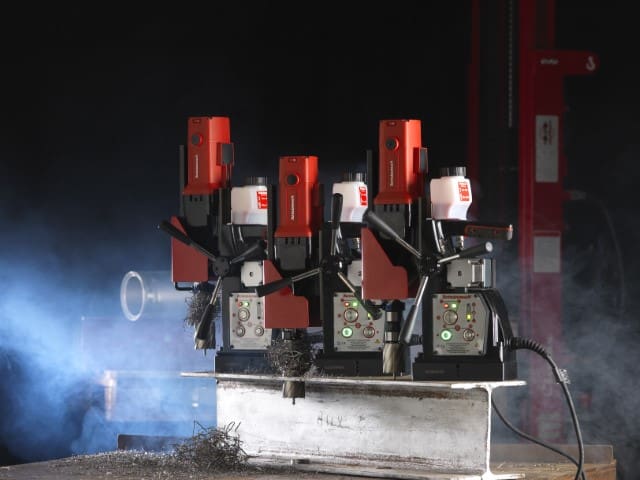Drilling is a crucial part of numerous industries, at Rotabroach we provide the tools for companies across the world to complete large-scale projects to the highest standards, here’s how:
Which industries use Rotabroach products?
Rotabroach products can be found in a variety of different industries, from construction and rail, to shipbuilding, oil and gas production and many, many more. These sectors rely on quality, hard-wearing products, capable of performing in the most difficult environments without compromise. For this reason, Rotabroach has been producing market-leading magnetic drills, annular cutters and a wide range of related equipment to help businesses complete ambitious projects and perform critical maintenance with tools they can rely on.
Why Rotabroach?
With an esteemed reputation built by decades of consistent quality, Rotabroach has established itself as the premier name in the mag drill industry, along with market-leading annular cutters and other related products. This rich heritage, combined with cutting-edge innovation, makes Rotabroach a key part of multiple industries, relied upon to deliver quality and performance in the most challenging environments.
Powering the drilling industry
Natural resources drilling is a critical part of the world economy, with more than three-quarters of the United Kingdom’s primary energy needs accounted for by oil and gas in recent years, similarly to many other countries.
Therefore, the oil industry and natural gas industry require efficient, consistent maintenance and large-scale new projects require extremely high levels of planning and careful execution. Rotabroach’s range of specialist adaptable drills are perfectly suited to the unique challenges of these industries and the complex environments they tackle on a daily basis.
So, how does the drilling process work?
The drilling process for oil and natural gas is essentially the same and can be simplified into the following stages:
- Preparing the rig site
- Drilling
- Cementing and Testing
- Well Completion
- Fracking
- Production and Fracking Fluid Recycling
- Well Abandonment and Land Restoration
These stages are are consistent between both oil and natural gas drilling, with drilling operations started and carried out in similar ways. To understand Rotabroach’s place in all this, it is key to know these stages in more detail.
Preparing the drilling rig site.
Before an organization can begin drilling operations, they must first produce the infrastructure necessary to facilitate safe, responsible and compliant drilling. This includes providing pads and access roads, as well as water and electricity facilities. Having planned and surveyed the site, as well as providing this infrastructure, safety procedures and obtaining relevant permits beforehand, the start of the drilling process can begin.
Drilling
With the preparatory stage of the drilling site completed, it is then possible to begin drilling the initial surface hole. This is drilled past the deepest fresh water aquifer (to avoid contaminating water supplies), before the drill pipe is removed and replaced with steel pipe, otherwise known as ‘surface casing’. In order to keep the drill bit cool during this process, a special drilling mud is used to regulate the temperature of the drill bit, as well as providing stability to the walls of the borehole and removing loose rocks.
Cement is then pumped down this surface casing, and back up between the casing and the borehole, creating a vital impermeable barrier between the bore hole and nearby fresh water sources. Before continuing, testing takes place to ensure than the cement barrier is completely impermeable and there is no risk of contamination. This approach, known as vertical drilling, is an essential part of oil or natural gas production.
Alongside this, horizontal drilling is another approach which is applied in the oil and natural gas sector. When drilling for hydrocarbons in a shale formation it is necessary to drill horizontally, this begins with a vertically-drilled well which drills to a specific depth, called the ‘kick-off point’, where the well bore begins to curve horizontally.
A key advantage of this approach is its potential to drill several laterals from a single surface drilling pad, this minimizes the impact and scale of activity on the above drilling rig, therefore reducing disturbance. When the target distance is reached, drill pipe is removed and more steel casing is inserted throughout the well bore, cemented in place similarly to the vertical drilling process. After this stage is completed, the well completion process can take place.
Well Completion
Having produced the final casing, the next stage is to create a connection between this surface casing and the rock layer holding the oil and gas. To do this, a specialized ‘perforating gun’ is lowered to the rock layer, firing to create holes between the casing pipe and into the target rock, piercing the cement layer. These perforating holes, only inches long, do not cause any detectable activity on the surface. Once completed, the perforating gun is removed and the next stage, hydraulic fracturing, can begin.
Hydraulic fracturing
Hydraulic fracturing, otherwise known as fracking, is the next stage of the oil and natural gas drilling process. This begins with stimulation fluid, a mixture of <90% water and sand (with some chemical additives) is pumped under high pressure into deep underground reservoir formations. The chemicals used in fracturing fluid are for lubrication and preventing bacteria formation. They are non-hazardous, low concentration and are necessary to improve the performance and efficiency of hydraulic fracturing.
The stimulation fluid is pumped through the perforations made by the perforating gun, this will hydraulically fracture the shale rock which contains the target natural gas. The sand remains in the rock fractures to keep them open whilst pump pressure is relieved, allowing previously trapped oil and gas to flow to the well bore.
Oil and natural gas production
Once the hydraulic fracturing process has taken place, the well can begin to produce oil. The oil and natural gas flow from the well bore and the fracturing fluid is recovered. During the initial production of a well, roughly 25-75% of fracturing fluid is recovered and either recycled in other fracturing operations, or disposed of in a fashion complying with government environmental regulations.
The process of developing a well, as described, typically takes roughly 3-5 months in total with the following timeline;
- Preparing the site: a few weeks
- Drilling the well: eight to twelve weeks
- Completing the well and stimulation: one to three months
This relatively short timeline carries a significant financial investment, however it has the potential to produce a well which can provide oil and gas for decades to come. However, when all of the economically viable resources have been depleted, drilling rigs must be decommissioned in a specific process.
Well Abandonment
Having extracted all of the viable oil and natural gas, the land used by the drill site must be returned to its original state prior to the operation’s start. This is achieved by filling the well with cement and cutting all drill pipe off ~6 feet below ground level. Having filled the surface hole all surface equipment will be removed and any well pads filled in. This returns the land to its initial state, with minimal evidence of a well site having existed.
So, how does Rotabroach fit into this?
As discussed, drilling for oil and gas requires significant amounts of construction and infrastructure. Working with steel structures, hard alloys and tight spaces requires a special kind of equipment. This is where Rotabroach comes in; producing dependable, high-performance equipment, Rotabroach supplies these industries with the tools to take on specialized challenges where competitors cannot. For example, the ATEX approved Eagle and Raven drills provide the necessary power in combustible environments, ensuring user safety and minimizing risk.
Offshore drilling takes these unique challenges and amplifies them, introducing difficult environmental elements into the mix and pushing tools to their limit. Luckily, Rotabroach tools are prepared for any environment, able to maintain performance where others fail, the superior build quality of Rotabroach products ensures that they remain the market-leading choice for drilling applications.


